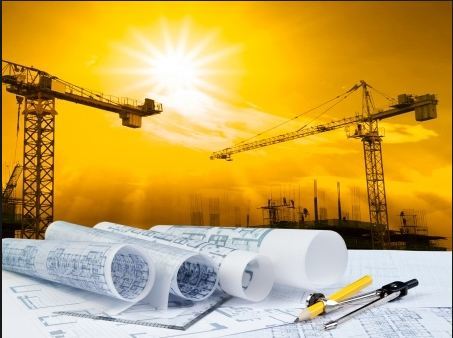Tiếng Anh chuyên ngành kinh tế xây dựng vốn không hề dễ dàng cho những người học tiếng Anh vì nó đòi hỏi vốn kiến thức ở cả hai lĩnh vực: kinh tế và xây dựng. Trong bài học hôm nay, trung tâm Anh ngữ Aroma xin gửi đến các bạn một bài đọc ngắn về “civil engineering” trong chủ đề lớn này nhé.

Bài đọc tiếng anh chuyên ngành kinh tế xây dựng
Originally, the term civil engineering came into use to distinguish it from military engineering. While civil engineering dealt with permanent structures for civilian use military engineering dealt with temporary structures for military one. An example of the latter is the bridge built across the Rhine in 55 B.C. which is described in Julius Caesar’s Commentaries on the Gallic War. A more appropriate definition of civil engineering is that it involves the design and construction of objects that are intended to be stationary. In practice, this definition includes buildings and houses, dams, tunnels, bridges, sanitation systems, canals and the stationary parts of transportation systems – highways, port facilities, airports, and roadbeds for railroads.
Civil engineering offers a particular challenge since almost every system or structure that is designed and built by civil engineers is unique. One structure seldom duplicates another exactly. Even when structures seem to be identical, site requirements or other factors generally lead to modifications. Large structures like bridges, dams, or tunnels may differ substantially from previous structures. Therefore, the civil engineer must always be ready and willing to confront new challenges.
Within the field of civil engineering itself, there are subdivisions: structural engineering, which is concerned with permanent structures; hydraulic engineering, which deals with systems involving the flow and control of water or other fluids; and sanitary or environmental engineering, which involves the study of water supply, purification, and sewer systems. Obviously, many of these specialities overlap. For example, a water supply system may involve dams, and other structures as well as the flow and storage of water.
Many different types of engineers usually work on large projects, such as space exploration or nuclear-power development. In the space program, for example, the launching pads and the rockets assembly and storage building at Cape Canaveral, Florida – the largest such structure in the world – are primarily the work of civil engineers. In a nuclear power plant, civil engineers are in charge of the design and construction of the plant itself, as well as the protective shielding around the nuclear reactor. Nevertheless, in both these cases, the civil engineers work with specialists in nuclear, aerospace and electrical engineering. In projects of this type, the engineer is a member of a team that is often headed by a systems engineer who coordinates the contributions of all members of the team. As teamwork is crucial in so many engineering projects nowadays, an important qualification for engineers is the ability to work with other people successfully.
The result of the growth in scientific knowledge is that engineering has grown into a profession. A profession is an occupation like medicine, law, or engineering that requires specialized, advanced education; indeed, they are often called the “learned profession”. Until the nineteenth century, engineers usually were craftsmen or project organizers who learned their skills through apprenticeship, on-the-job training, or trial and error. Nowadays, many engineers spend years studying at institutions for advanced degrees. Yet even those engineers who do not study for advanced degrees must be aware of changes in their field and those related to it. A civil engineer who does not know about new materials that have been made available cannot compete successfully with one who does.
(Source: Lê Thị Hoài Thao và các cộng sự, English of civil engineering, trung tâm bồi dưỡng cán bộ, Bộ Xây dựng 1997)
Vocabulary
temporary (adj): tạm thời
appropriate (adj): thích hợp
structure (n): kết cấu, structural (adj)
dam (n): đập nước
sanitation (n) sự cải thiện, điều kiện vệ sinh
roadbed (n): nền đường
challenge (n): sự thách thức
unique (adj): duy nhất
duplicate (v): sao lại, làm thành 2 bản, nhân đôi
identical (adj): giống hệt nhau
substantial (adj): lớn lao, quan trọng, thực tế
willing (adj): tự nguyện, sẵn lòng
subdivision (n): sự phân nhỏ, phân nhánh, bộ phận
hydraulic (adj): thủy lực, chạy bằng sức nước
environment (n): môi trường
purify (v) lọc, làm sạch
sewer (n): cống rãnh
overlap (v): gối lên nhau, chồng chéo
obviously (adv): rõ ràng, hiển nhiên
result in (v): gây nên, có tác động tới, đưa kết quả
nuclear reactor (n) lò phản ứng nguyên tử
shielding (n): tấm, lớp che chắn
specialties(n): ngành chuyên môn
modification (n): sự thay đổi, sự sửa đổi
military engineering (n) xây dựng quân đội
purification (n) sự làm sạch, lọc sạch
distinguish (v): phân biệt
originally (adv) nguồn gốc, ban đầu
storage (n): sự lưu trữ, dự trữ
Trên đây là bài đọc về tiếng Anh ngành xây dựng kèm từ vựng liên quan. Hy vọng các bạn đã có những kiến thức bổ ích.
Có thể bạn quan tâm:
